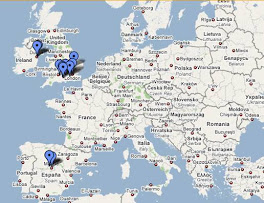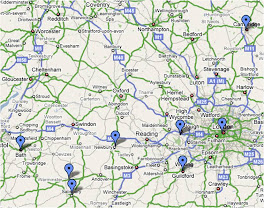The first of these was Portobello Road. Every major European city can boast its own share of street markets where money-conscious travelers can either find themselves picking up a unique souvenir or an expensive piece of junk. (I've learned that the stereotype of the American tourist is one that jumps at any sale sign that proclaims "FREE" or "CHEAP".) A flea-market junkie myself, I had been wanting to browse through the stalls of London's largest street market in hopes of picking up a few characteristic mementos of my semester in England. A less avid shopper, Bill graciously tolerated my shopping whim. Still rubbing sleep from our eyes, we hopped on a train from Guildford at 7 a.m. and arrived at Portobello Road before 8 o'clock. Working off a tip printed in the BBC, I had wanted to arrive just as the vendors were setting up shop to ensure that we could have the best prices and selection. Looking back, I think that we may have arrived just a little too early. Though most vendors had claimed their tables by 8 a.m., few were truly ready to begin haggling until an hour later. This became evident when Bill and I stopped by a pastry stand to buy croissants for an early morning snack. When we asked for the price of the pastries, the baker replied, "One pound each." Walking past the stand an hour later, I scoffed to discover that the price tag on the croissants clearly stated, "Eighty pence per pastry." (The American in me wants to contact the Better Business Bureau, while the Brit in the back of my head shrugs and says, "Rubbish, it's your own damn fault.") After an initial run-through of the street market to grab our bearings, we headed back through the ever-growing crowds to start a bit of serious shopping. The goods sold at Portobello Road can be grouped into one of the following classes:
- priceless antiques,
- worthless junk that looks antique,
- touristy souvenirs,
- interesting but cheap clothing, and
- food of every variety.
After only a few short hours, Bill and I decided that we had seen enough of Portobello Road and headed off to the nearest Underground station to begin a day of museum-hopping throughout the city. The greatest part about museums in London is that most of them are free. The lack of admission prices gave Bill and I the freedom to jump from museum to museum without getting burnt out on a single exhibit genre, which often happens when browsing through the upper level collections of history, science, and art. We started our museum tour with the London Science Museum. One of the best signs of a good friendship is the willing to compromise, which defines a lot of the decisions that Bill and I make on our weekend city trips. In this case, Bill survived my shopping spree on Portobello Road, and I gave in to spending a few hours in the Science Museum. A major fan of gadgets and interesting phenomenon, Bill was thrilled to browse through flight exhibits, technology displays, and the eclectic selection of toys in the museum gift shop. Don't get me wrong -- I love science just as much as my biomedical-partner-in-crime, but there was one main thought about the Science Museum that I couldn't get out of my head while we were hopping from floor to floor: 50% of the exhibits were American driven. No joke! Probably the biggest display in the museum was the flight exhibit, which sported replicas of airplanes, space shuttles, and other early flight inventions. Where was human flight first achieved? America! What country first landed on the moon? America! Who has sent more probes, imaging devices, and astronauts into space? America! (Get my point?!) I don't mean to act a little snug with my nationality, but it's hard to come from the U.S. state that was home to the Wright Brothers, Neil Armstrong, and John Glenn, and then try to experience European culture in a pre-dominantly American exhibit. So here's my recommendation for the London Science Museum: If you've seen COSI or any of the Smithsonians, then you won't find anything new in any European science museum. If not, then you might see something that peaks your interest.
After taking a few moments to gobble down a quick packed lunch, we walked a few steps down the street to the London National History Museum. One thing that I would love to thank my parents for is the hundreds of museums that they made me see throughout my childhood. Ranging from art to science and political history to natural history, I am thankful that I can distinguish between a good museum collection and a bad one. The London Natural History Museum falls somewhere in the middle. A step up from the previous museum, the best part about the Natural History Museum was the dozens of rooms with stuffed animals. Donated by generous animal collectors, I was very impressed with some of the animal displays -- particularly the bird exhibits. In one room, Bill and I came across a decently-sized glass cabinet with nearly a hundred small birds of every color, species, and variety. The birds were perfectly preserved and positioned on branches of a metal tree, which made them look as if they would quickly take off in flight. It was the most beautiful display of natural history that I have ever seen. The main disappointment of the Natural History Museum was the fossil exhibit. Having seen the world's largest dinosaur collection at the Chicago Natural History Museum as a child, I was expecting to see a large room with a giant Tyrannosaurus Rex posed to pounce on its next unfortunate prey. Following the signs to the T.Rex exhibit, I couldn't stop babbling to Bill about the awesomeness of the dinosaur king. After waiting in line for nearly twenty minutes, we stepped into the T.Rex room only to find that our "Tyrannosaurus Rex" was actually a computer-controlled robot that roared at museum tourists as they passed through the room. In disbelief that this was the extent of the T.Rex exhibit, I ran from room to room in hopes of finding a real fossilized skeleton of the giant lizard. Unfortunately, my efforts were in vain as disappointment quickly set in. So here's my overall impression of the London Natural History Museum: In my opinion, this one is better than the Science Museum, but don't get your hopes up too high for an overwhelming dinosaur exhibit. Though there were several large dinosaur fossils to be seen, the king of prehistoric lizards fails to make a true appearance.
Giving ourselves a few minutes to rest our feet in Trafalgar Square, Bill and I eventually made our way to the last museum stop of the day: The National Gallery. For those of you outside the London loop, the National Gallery is a very large art museum with works by DaVinci, Michaelangeo, Rembrandt, and VanGogh as well as several other famous art masters. The National Gallery is one museum that I was very grateful to tour with Bill. Having taken an art history class in high school, Bill noticed aspects of paintings that I never would have spotted with my relatively untrained eye. Needless to say, Bill was reveling in the fact that he was able to see paintings that he could only study previously from a textbook. By far, my favorite painting was DaVinci's "Virgin of the Rocks". For those of you who are fans of Dan Brown's The DaVinci Code, you may remember that Leonardo DaVinci painted two almost identical paintings. One was entitled "Madonna of the Rocks" while the other is known as "Virgin of the Rocks". The latter of the two bears a more pronounced religious presence, which Dan Brown uses in his amazing best-selling novel. To avoid a DaVinci Code tangent here, I loved "Virgin of the Rocks" mainly because DaVinci had a gift for painting the most beautiful faces that I have ever encountered. While most artists use color to create a masterpiece, DaVinci uses shadow to set his paintings apart from others. The angelic faces created by DaVinci in his paintings toy with the mind by his creative use of light and dark. Anyone who may have clicked on the hyperlink above to see a preview of this painting might just shrug and say, "This painting looks alright, but nothing special for the most part." A few months ago, I would have completely agreed with this statement, but upon seeing the painting in person, my breath caught in my throat and I actually felt emotionally shaken by the beauty of this masterpiece. The other paintings displayed in the National Gallery collection are virtually indescribable. I saw paintings of the epiphany where the gifts given to Christ from the Magi were so detailed that they appeared to be real golden vessels. Additionally, there were paintings that had the most creative hidden optical illusions that even the most skeptical art-goer would be amused by the cleverness of the artist. So before I get too wrapped up in my many praises for the London National Gallery, here's my overall recommendation: European art collections trump American art museums ten to one. I have never seen art this beautiful, colorful, or emotionally moving than the paintings in the National Gallery. With plans to see the Paris Louvre in November, I'm curious to see how the National Gallery compares to the most famous art museum in the world.
With plans to re-visit the National Gallery, Bill and I rushed off to St. Paul's Cathedral in hopes of catching Evensong (an evening Anglican church service). If you don't have time to tour famous European churches or don't want to pay the admission price, the best way to see the inside of a cathedral or abbey is to attend a church service. With dusk quickly falling across London, beautiful candle-lit shadows played across the walls of St. Paul's Cathedral. Much newer than Westminster Abbey, St. Paul's is no less majestic. Gorgeous mosaics adorned the ceilings of the extremely tall chapel, chandeliers hung from every corner, and the cathedral's infamous dome was painted with black-and-creme biblical scenes that were perfectly clear to the on-lookers over a hundred feet below. Despite having no loyalties to the Church of England, I was eager to attend Evensong just to hear the "choir of men and boys" reverberate their voices throughout the walls of the cathedral. Growing up in a musical family, I knew enough about music to instant realize that the sound produced by the choir was positively heavenly. The acoustical design of the church was so incredible that the sound vibrated across the chapel in such a way that no echo was produced -- only a constant ringing that sounded as if a giant bell choir was giving an exclusive performance. With the entire service taking place by candlelight and dimly-lit chandeliers, the chapel seemed almost magical with glorious music, beautiful art, and a quiet place to rest the feet of even the weariest traveler.
You may need to forgive my slightly nostalgic description of the National Gallery and St. Paul's Cathedral. Whether it be churches, art, music, or even a good story, sometimes you run across something that touches you in an emotionally indescribable way that you want to put into words but can never find phrases powerful enough to describe the experience to others. That is what these masterpieces did to me. No matter what words I use or how many sentences I write, St. Paul's and the National Gallery are two places that can only be experienced if you visit them yourself. I cannot stress enough the importance of seeing parts of the world outside the comfort of your home. No amount of money or time can replace the amazing things that I have already seen during my first month in Europe.
(Stepping down from my soapbox...)
To finish our day, Bill and I relaxed at a great restaurant in downtown London before heading back to Guildford via train. Feeling that we've exhausted almost all of the major tourist sites in England's most beloved city, we're ready to start tackling other parts of Britain and Europe. Next weekend brings CAMBRIDGE!











No comments:
Post a Comment